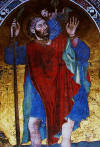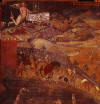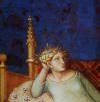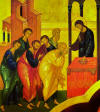Search:: Artists Alphabetically Artists by Country Artists by Century Artists by Movement
The Sienese School
1250-1640
Examples of Sienese painting (click to Enlarge)
From
its vantage point high in the Tuscan hills, Sienna was exceptionally
well placed to become one of the greatest artistic centers of medieval
Europe. Throughout the Middle Ages, Italian art was largely
traditional, sticking to the techniques and style established by the
Byzantine Church. Sienese artists for the most part, left
Byzantine conventions behind and were leading the way towards the
Renaissance, although some Byzantine flavor lingered in Sienese
painting.
In the Spring 1348 the Black Death was spreading quickly throughout the Italian countryside. In Siena the plague wiped out 80,000 people in just seven months. Many Sienese painters, including the brothers Pietro and Ambrogio Lorenzetti perished.
Early Sienese painters
created magnificent paintings for the Civic Museum inside the
Palazzo Pubblico overlooking the Piazza del Campo. The Palazzo Pubblico
was built in the early 1300s by the Government of Nove. It is a
masterpiece of medieval urban architecture. In the Great
Council Hall there are extraordinary frescoes by Simone Martini
depicting a beautiful Maestąand
next door, in the Hall of Nine there is the amazing fresco
cycle by Ambrogio
Lorenzetti showing
the Allegory and Effects of Good and Bad Government.
Key Descriptive Words and Phrases associated with the Renaissance Movement - rebirth, rediscovery of the classical world, City-state, Humanism, Humanist, Francesco Petrarch, Reform, The Prince, Theocracy, The Inquisition, Human Reasoning, publication of Della Pittura, a book about the laws of mathematical perspective for artists, sfumato, chiaroscuro, linear perspective, Heliocentric Theory, vanishing point, Savonarola, spiritually significant, illuminated manuscript, idealized biblical themes, scriptorium, emotion, illuminator, iconoclast, Age of Discovery, axonometric drawing, curiosity about the natural world, mythology, realistic use of colours and light, Bonfire of the Vanities, Old Testament stories, ethereal and foggy backgrounds, Gospel parables, The Blackdeath, romanticized landscapes, Christian symbolism. Paradise
☼☼☼☼☼
1250–1300
Duccio di Buoninsegna founder of the Sienese School
Guido da Siena
Coppo di Marcovaldo
1301–1350
Barna da Siena
Pietro Lorenzetti
Ambrogio Lorenzetti
Ugolino Lorenzetti
Lippo Memmi
Segna di Buonaventure
Simone Martini
1351–1400
Taddeo di Bartolo
Bartolo di Fredi
Spinello Aretino
Andrea Vanni
1401–1450
Giovani di Paolo
Pietro di Giovanni d'Ambrogio
Sassetta
1451–1500
Sano di Pietro
Matteo di Giovanni
Neroccio dei Landi
1501–1550
Ddomenco Beccafumi
Sodoma
1601–1640
Ventura Salimbeni
Search for Artists by Century Important Painters Born in the 13th Century Important Painters Born in the 14th Century Important Painters Born in the 15th Century Important Painters Born in the 16th Century Important Painters Born in the 17th Century Important Painters Born in the 18th Century Important Painters Born in the 19th Century
Require more facts and information about the painter and the artists of the renaissance era? Poke around every nook and cranny of the known universe for information this subject. Search Here
© HistoryofPainters.com If you like this page and wish to share it, you are welcome to link to it, with our thanks. updated 3/7/2017







